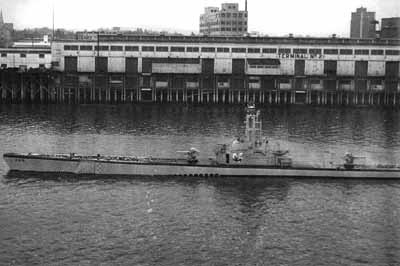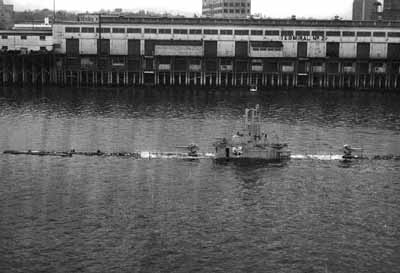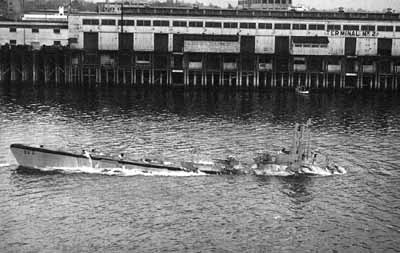Hawkbill SS-366 Participates in Navy Day Memorial 1945NAVY HONORS WAR II DEAD(From the Oregonian, dated Monday, October 28, 1945)
A floral tribute to the sea going dead of World War II floated toward the Pacific Sunday from the deck of the submarine Hawkbill in a dramatic conclusion to Navy day [10/27/45] memorial services at Portland. As taps sounded aboard the medium carrier Independence, where the services were held, the Hawkbill submerged its flower-blanketed decks in the middle of the Willamette river before several thousand spectators, spell-bound by the shrill hiss of air from ballast tanks. Approximately 75 gold star* mothers and wives of sailors, marines and coast guard men were guests of honor on the hangar deck of the Independence at the services, which were witnessed as well by Governor Earl Snell, Mayor Earl Riley and several hundred spectators. Before and after the services the ships in Portland for Navy day--the cruisers Amsterdam and Topeka, the carrier Independence, the destroyers Taylor and Woodworth and the submarine Hawkbill--were open to visitors, as they will be each day of Navy week between 1 and 4:30 P.M.. Two additional submarines, the Icefish and Jallao, will arrive Wednesday. * Gold stars indicated the loss of a son or husband.
"We got stuck on the bottom!" --Captain Scanland describes a problem encountered during this event. "After the end of hostilities and upon reaching the west coast, we were operationally ordered to proceed to Portland, Oregon to participate with several surface ships in the celebration of Navy Day and memorial to those Oregon servicemen lost in the conflict. It was a nice break for us and we had a good time. We surfed the gigantic waves at the mouth of the Columbia river and continued on up the river to Portland. We docked in Portland and met Mr. James Flood, the personal representative of the mayor." "The mayor asked if we would participate in the celebration by moving Hawkbill to the center of the river and submerge and remain on the bottom for a few minutes. In doing so, memorial flowers placed on the deck of the boat would wash downstream. Mr. Flood said he would signal when the flowers had cleared the area above Hawkbill. I was to watch through the periscope, for this signal to surface. At first I refused because the Willammette River was somewhat polluted. Our ballast tanks and torpedo tubes, which would need to be flooded from the river, would quickly lose their virginity of cleanliness from the sea waters where we had emptied them before entering the Columbia River. However when the discussion reached the point where Mr. Flood threatened to telephone the Secretary of Navy, I felt it the better part of valor to yield, which I did. One condition was that the city fill my ballast tanks with city water rather than from the river water. They agreed." "We had not the foggiest idea of the trim required for submerging in fresh water. Because we carried no added weight of torpedos or other wartime materials, I told the diving officer to fill every variable tank and torpedo tube in the boat from the city's water supply to insure that we would be heavily ballasted for sinking and not be embarrassed by hovering at the surface without submerging." "At the appropriate time, when we were in the center of the river. I could see thousands of the citizens of Portland waiting to see our boat submerge. I watched for a signal from the dignitaries on the shore platform to begin. Upon receiving this signal, I sounded the diving alarm and we cleared the bridge. As a result of all the ballast, we were so heavy that we disappeared in perhaps twenty seconds." "I raised the periscope and turned it to see the dignitary platform on shore and waited for their signal to surface. After several minutes, I saw some person on the platform waiving a white towel so I lowered the periscope and ordered Lt. Lou Fockele, my diving officer, to surface the boat and sounded the surface alarm. The chief petty officer at the high pressure air manifold opened the air valves to the main ballast tanks and blew them dry. The boat gave a shudder or two but otherwise didn't budge from its otherwise comfortable bed in the mud of the Willamette River. With some sense of alarm, I ordered the torpedo tubes and variable tanks pumped dry. At this point, there was no ballast water aboard the submarine but Hawkbill still did not budge a foot from her nest." "The gentleman on the platform was giving me frantic signs with his white towel encouraging me to surface. Of course he could not understand why we were not paying attention. It was clear to us the submarine's hull had stuck in the soft muck and the suction formed between the hull and cavity of soft mud was a dilemma for which we didn't have an answer. We were getting concerned and I thought back to the early nineteen-twenties when I was a youngster of ten years old or so. I had read one of the few books I could get my hands on about the German U-Boats of World War I. This particular story was about a U-Boat which had gone to the bottom of the Atlantic shelf off our east coast so he could rest during the day and be fresh for the next night's surface raiding. When it came time for him to surface, he found himself stuck as we were now stuck. He solved his problem by backing full speed on his propellers causing a wash to flow along the hull from stern to bow and broke the suction sufficiently to surface." "I ordered the propellers to be backed two-thirds speed and within about fifteen seconds there was a sudden jolt as we broke loose from the suction. It felt like a gigantic elevator as we shot to the surface and if I didn't know better, I had the impression that we cleared the surface of the river by several feet before we settled back down." "We moved to the pier and everyone was happy with our performance. The next day in the headlines of the Portland newspaper, an article exclaimed that it was little wonder that the United States defeated Japan--we had submarines that could submerge in a matter of a few seconds and suddenly surface even more quickly than they had submerged. It was miraculous what we could do."
"We kept the secret to ourselves."
|



